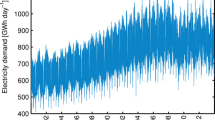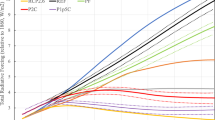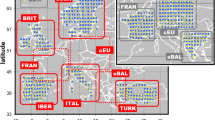Abstract
Climate data is used in many practical applications including energy demand estimations for heating and cooling, agricultural applications, risk assessment, and many more. The required climate data is only available if meteorological observations exist at a given location. In this study, the possibility of replacing long observational records with a few years of numerical weather forecast data is investigated for practical applications requiring temperature data. Observational data from 1980–2010, measured at 700 weather stations in Central Europe are used together with model forecasts of the years 2008–2010. Depending on the station, forecast data capture 90–110% of the standard deviation observed for daily mean and maximum temperatures and slightly less for minimum temperature. Heating and cooling degree days can be estimated with an error of 5–15% in climates where they have a relevance. Based on model data, maps of heating and cooling degree days are computed and the regional uncertainties are quantified using the observational data. The results suggest that numerical weather forecast data can be used for certain practical applications, either as a surrogate of observational data or for quite reliable estimates in locations with no observations.











Similar content being viewed by others
References
Allen JC (1976) A modified sine wave method for calculating degree days. Environ Entomol 5:388–396
Arnold CY (1974) Predicting stages of sweet corn development. J Am Soc Hortic Sci 99:501–505
van Asseldonk MAPM (2003) Insurance against weather risk: Use of heating degree-days from non-local stations for weather derivatives. Theor Appl Climatol 74:137–144
Colombo AF, Etkin D, Karney BW (1999) Climate variability and the frequency of extreme temperature events for nine sites across Canada: implications for power usage. J Climate 12:2490–2502
Day T (2006) Degree-days: theory and application, TM, vol 41. The Chartered Institution of Building Services Engineers, London, UK.
Eto JH (1988) On using degree-days to account for the effects of weather and annual energy use in office buildings. Energy Build 12:113–127
Foster JE, Taylor PL (1975) Thermal-unit requirements for development of the Hessian Fly under controlled environments. Environ Entomol 4:195–202
Janjic ZI (2003) A nonhydrostatic model based on a new approach. Meteorol Atmos Phys 82:271–285
Janjic ZI, Gerrity JP, Nickovic S (2001) An alternative approach to nonhydrostatic modeling. Mon Weather Rev 129:1164–1178
McVicker IFG (1946) The calculation and use of degree-days. J Inst Heat Vent Eng 14:252–299
Müller MD (2011) Effects of model resolution and statistical postprocessing on shelter temperature and wind forecasts. J Appl Meteor Climatol 50:1627–1636
Plett S (1992) Comparison of seasonal thermal indices for measurement of corn maturity in a prairie environment. Can J Plant Sci 72:1157–1162
Quayle RG, Diaz HF (1980) Heating degree-day data applied to residential heating energy consumption. J Appl Meteorol 19:241–246
Wilks DS, Wilby RL (1999) The weather generation game: a review of stochastic weather models. Prog Phys Geogr 23:329–357
Acknowledgements
We would like to thank the NCDC in Asheville, NC for providing the observational data used in this study. Furthermore, we would like to express our gratitude to the anonymous reviewers.
Author information
Authors and Affiliations
Corresponding author
Rights and permissions
About this article
Cite this article
Müller, M.D., Parlow, E. Numerical weather prediction as a surrogate for climate observations in practical applications. Theor Appl Climatol 111, 577–584 (2013). https://doi.org/10.1007/s00704-012-0693-z
Received:
Accepted:
Published:
Issue Date:
DOI: https://doi.org/10.1007/s00704-012-0693-z




